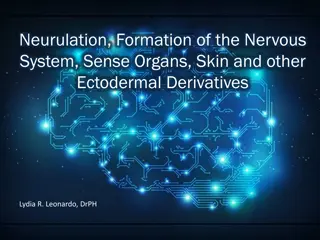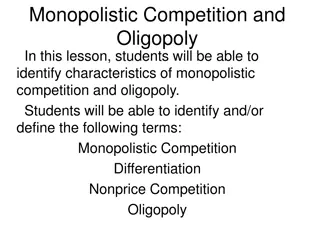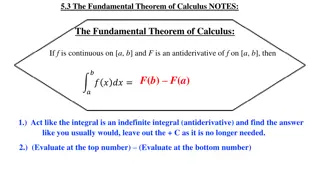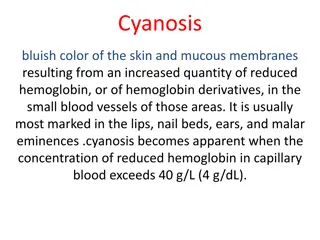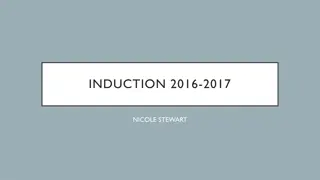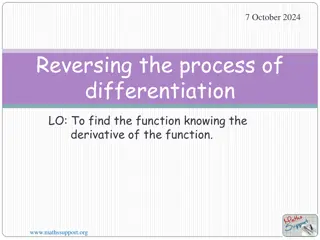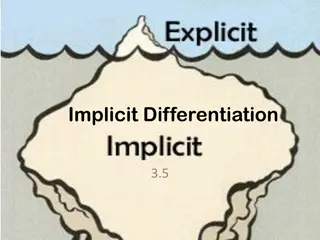
Differentiation: Gradients, Equations, and Formulas
Explore the concept of differentiation by learning about gradients, equations of straight lines, and calculating gradients at specific points. Discover methods to estimate gradients and algebraic versions to understand the change in y over the change in x.
Download Presentation

Please find below an Image/Link to download the presentation.
The content on the website is provided AS IS for your information and personal use only. It may not be sold, licensed, or shared on other websites without obtaining consent from the author. If you encounter any issues during the download, it is possible that the publisher has removed the file from their server.
You are allowed to download the files provided on this website for personal or commercial use, subject to the condition that they are used lawfully. All files are the property of their respective owners.
The content on the website is provided AS IS for your information and personal use only. It may not be sold, licensed, or shared on other websites without obtaining consent from the author.
E N D
Presentation Transcript
Differentiation Differentiation Twitter: @Owen134866 www.mathsfreeresourcelibrary.com
Prior Knowledge Check 1) Find the gradients of these lines: 3) Find the equation of the straight line that passes through: a) (0,-2) and (6,1) b) (3,7) and (9,4) c) (10,5) and (-2,8) ? =? (6,6) ?? ? ?? +?? ? = ? 4 4 ? 1 6 -5 ? = ? ?? +?? 5 ? -2/3 1/3 2) Write each of these in the form xn. a) ?3 ?7 ??? 4) Find the equation of the perpendicular to the line ? = 2? 5 at the point (2,-1) b) 3?2 ? ? ? ? = ? ?? c) ?2 ?3 ?2 ?6 ? ? d) ? ? ? ?
Teachings for Teachings for Exercise 12B Exercise 12B
Differentiation What can you say about the gradient of the graph to the right? ? = ?(?) How would you work out the gradient at a specific point? As the gradient changes, there must be a formula to calculate the gradient, based on the position on the curve
Differentiation y To the right is a part of a graph. ? = ?(?) Imagine we want to estimate the gradient between any 2 points on the graph Change in y ???????? =? ???? ?? ? ? ???? ?? ? Change in x Way too many words here lets use algebra! x
Differentiation y Algebraic version ? = ?(?) Original coordinate New ? + ??,? ? + ?? coordinate (?,? ? ) (? + ??,? ? + ?? ) ? ? + ?? ?(?) ?? ??= ? ? + ?? ?(?) ?? ?? ?,? ? This means the change in y divided by the change in x x
Differentiation y ?? ??= ? ? + ?? ?(?) ?? ? = ?(?) ? + ??,? ? + ?? This however tells us the gradient between two points. ? ? + ?? ?(?) What happens as we start to consider finding the gradient at a specific point? ??tends towards 0 This is what that looks like ?? ??= lim ? ? + ?? ?(?) ?? lim ?? 0 ?? ?,? ? ?? 0 x The limit as ?? tends towards 0
Differentiation y ?? ??= lim ? ? + ?? ?(?) ?? ? = ?? lim ?? 0 ?? 0 ? + ??, ? + ??? Replace the functions ? + ??2 ?2 ?? ?? ??= lim lim ?? 0 ? + ??? ?? Expand the bracket The x2 terms cancel each other ?? 0 ?2+ 2??? + ??2 ?2 ?? ?? ??= lim ?? 0 lim ?? 0 2??? + ??2 ?? ?? ??= ?,?? lim ?? 0 lim ?? 0 ?? Divide all by ?? x ?? ??= lim ?? 0 lim ?? 02? + ?? What happens as we approach a single point instead of 2 separate ones? ?? ??= 2? ?? 0
Differentiation y The function If: ? = ?2 ? = ?? The gradient function (formula for the gradient, in terms of x) ?? ??= 2? Then: Find the gradient of the curve ? = ?2 at the coordinate (3,9) The gradient at this exact point is 6 ?? ??= 2? The x-coordinate at this point is 4 ?? ??= 2(3) x ? Calculate it! = 6
Differentiation You can use algebra to find the exact gradient of a curve at a given point. A point A with coordinates (4,16) lies on the curve with equation ? = ?2. At point A the curve has gradient ?. ? = lim 0(8 + ) Be aware that sometimes the letter h is used to represent the change in x a) Show that ? = lim ?? 0(8 + ??) b) Deduce the value of ? 12B
?? ??= lim ? ? + ?? ?(?) ?? Differentiation lim ?? 0 ?? 0 We can use g to represent the gradient here You can use algebra to find the exact gradient of a curve at a given point. ? ? + ?? ?(?) ?? ? = lim Replace the value of x, and use the function given in the question ?? 0 4 + ??2 (4)2 ?? A point A with coordinates (4,16) lies on the curve with equation ? = ?2. At point A the curve has gradient ?. ? = lim ?? 0 Expand brackets 16 + 8?? + (??)2 16 ?? ? = lim ?? 0 Group like terms a) Show that ? = lim ?? 0(8 + ??) 8?? + (??)2 ?? ? = lim ?? 0 Divide all by ?? b) Deduce the value of ? ? = lim ?? 0(8 + ??) b) As ?? 0 the limiting value is 8, so the gradient at point A is 8 12B
Differentiation ?? ??= lim ? ? + ?? ?(?) ?? lim ?? 0 ?? 0 Can you find a formula for the gradient for each of these curves using the method shown? Use it to find the gradient where x = 2 for each! d) ? = 2?3 e) ? = ?4 a) ? = ?3 b) ? = ?2+ 4 c) ? = ?2+ 4?
Teachings for Teachings for Exercise 12C Exercise 12C
Differentiation You can use the definition of the derivative to find an expression for the derivative of ?? where ? is any number. As a general rule, to differentiate a function The function If ? ? = ??? If ? = ??? Its derivative (formula for the gradient, in terms of x) Then ? ? = ???? 1 Then ?? ??= ???? 1 The letter d is commonly used to indicate that the tending to 0 from section B has happened (as opposed to ?) Both types of notation are still used so you need to be familiar with both Gottfried Leibniz s notation Joseph Lagrange s notation 12C
Differentiation a) ? ? = ?6 You can use the definition of the derivative to find an expression for the derivative of ?? where ? is any number. Multiply by the power and reduce it by 1 ? ? = 6?5 Find ? ? for each of the expressions for ?(?) to the right. 1 2 b) ? ? = ? Multiply by the power and reduce it by 1 ? ? =1 2? 1 =1 2 If ? ? = ??? You need to be able to rewrite this. This of it as two fractions multiplied together 2 ? 1 Then ? ? = ???? 1 2 Rewrite the second using index rules =1 1 2 ? Group together 1 = 2 ? 12C
Differentiation c) ? ? = ? 2 You can use the definition of the derivative to find an expression for the derivative of ?? where ? is any number. Multiply by the power and reduce it by 1 Think of it as 2 terms multiplied together ? ? = 2? 3 = 2 ? 3 = 2 1 Rewrite the second Find ? ? for each of the expressions for ?(?) to the right. ?3 Group together = 2 If ? ? = ??? ?3 Then ? ? = ???? 1 12C
Differentiation d) ? ? = ?2 ?3 You can use the definition of the derivative to find an expression for the derivative of ?? where ? is any number. Multiply terms together first ? ? = ?5 Multiply by the power and reduce it by 1 ? (?) = 5?4 Find ? ? for each of the expressions for ?(?) to the right. If ? ? = ??? Then ? ? = ???? 1 12C
Differentiation ? ?5 You can use the definition of the derivative to find an expression for the derivative of ?? where ? is any number. e) ? ? = Rewrite ? ? = ? 4 Differentiate ? ? = 4? 5 Think of it as 2 terms multiplied together Find ? ? for each of the expressions for ?(?) to the right. = 4 ? 5 Rewrite the second term = 4 1 If ? ? = ??? ?5 Group together = 4 Then ? ? = ???? 1 ?5 12C
Differentiation f) ? ? = 7?3 You can use the definition of the derivative to find an expression for the derivative of ?? where ? is any number. Differentiate ? ? = 21?2 Find ? ? for each of the expressions for ?(?) to the right. If ? ? = ??? Then ? ? = ???? 1 12C
Differentiation 1 2 You can use the definition of the derivative to find an expression for the derivative of ?? where ? is any number. g) ? ? = 4? Differentiate ? ? = 2? 1 2 This of it as 2 terms multiplied together = 2 ? 1 Find ? ? for each of the expressions for ?(?) to the right. 2 Rewrite the second term 1 = 2 If ? ? = ??? ? Group together 2 Then ? ? = ???? 1 = ? 12C
Differentiation You can use the definition of the derivative to find an expression for the derivative of ?? where ? is any number. h) ? ? = 36?3 Rewrite 36 ?3 ? ? = Square root each part / rewrite using indices 3 2 ? ? = 6? Find ? ? for each of the expressions for ?(?) to the right. Differentiate 1 2 ? ? = 9? If ? ? = ??? Rewrite = 9 ? Then ? ? = ???? 1 12C
Differentiation As you have also learnt about the binomial expansion, we can prove the differentiation rule for any power of x ??: ? ? = ??? ? ??: ? ? = ???? 1 12C
Differentiation ?! ? ? = Binomial Expansion reminder! (? + ?)? ? ? !?! ? 0?? ? 1?? 1? ? 2?? 2?2 ? 3?? 3?3+ + ? ??? = + + + ?! ? 1 ?! ? 2 0! is defined as 1 ?! = ? = +?(? 1) 0 +?(? 1)(? 2) =1 2 3 .. (? 2) (? 1) ? 1 2 3 .. (? 2) 2! = ? 1 !1! ? ??? ? 2 !2! = ?? + ??? 1? ?? 2?2 = ? 1 ! ?? 3?3+ + ? 0 !0! 2! 3! ?! =?! ?! =1 2 3 .. (? 1) ? 1 2 3 .. (? 1) =?(? 1) = 1 2! = ? 12C
Differentiation (? + ?)? +?(? 1) +?(? 1)(? 2) ? ??? = ?? + ??? 1? ?? 2?2 ?? 3?3+ + 2! 3! Calculate the first 4 terms in the expansion of: ? + ?8 +8(7) +8(7)(6) = ?8 + 8?7? ?6?2 ?5?3 2 6 = ?8 + 8?7? + 28?6?2 + 56?5?3 12C
Differentiation y If:?(?) = ??? ?(?) = ??? ? + ??,? ? + ??? ? ? + ??? ??? ?? ?? ??= lim lim ?? 0 ? ? + ??? ??? ?? 0 Now we need the binomial expansion ?,??? ?? x 12C
Differentiation If:?(?) = ??? Let s rewrite the bracket using the binomial expansion ? ? + ??? ??? ?? ?? ??= lim lim ?? 0 ?? 0 ? + ??? ? 3 ?? 3(??)3+ + (??)? ? 1 ?? 1(??) ? 2 ?? 2(??)2+ = ?? + + = ??+ ??? 1(??)+ ?(? 1) ?? 2??2+ ?(? 1)(? 2) ?? 3??3+ + (??)? 2 6 12C
Differentiation If:?(?) = ??? ? ? + ??? ??? ?? ?? ??= lim Replace the bracket with the expansion lim ?? 0 ?? 0 ?(??+ ??? 1?? +? ? 1 ?? 2??2+......+(??)?) ??? 2 = lim ?? 0 ?? Multiply out ???+ ???? 1?? +?? ? 1 ?? 2??2+......+?(??)? ??? 2 = lim ?? 0 ?? Group terms ???? 1?? +?? ? 1 ?? 2??2+......+?(??)? 2 = lim ?? 0 ?? 12C
Differentiation If:?(?) = ??? n-1 1 ???? 1?? +?? ? 1 ?? 2??2+......+?(??)? ?? ??= lim 2 lim ?? 0 ?? ?? 0 Divide all by ?? ?? 0 ???? 1+?? ? 1 ?? ?? As ?? tends towards, 0, any terms including it will do as well! ?? 2?? +......+?(??)? 1 = lim lim ?? 0 2 ?? ?? Everything in- between will also contain a ?? term = ???? 1 12C
Teachings for Teachings for Exercise 12D and 12E Exercise 12D and 12E
Differentiation Find ?? ?? when ? = ?2 6? 4 You can differentiate a function with several terms by differentiating each term separately. = 2 6 4 y x x Differentiate each term separately. A number on its own disappears If you have several terms, differentiate them all separately. dy dx=2x 6 You should do any re-writing you need to before differentiating anything 12D/E
Differentiation Find ?? ?? when ? = ?2 6? 4 You can differentiate a function with several terms by differentiating each term separately. = 2 6 4 y x x If you have several terms, differentiate them all separately. = 4?0 = 6?1 Multiply by power, reduce power by 1 Multiply by power, reduce power by 1 You should do any re-writing you need to before differentiating anything = 6?0 = 0 x0 = 1 = 6 So terms that are just a number will cancel out! 12D/E
Differentiation You can differentiate a function with several terms by differentiating each term separately. Find the gradient of the curve ? = ?3+ ?2 when ? = 2 ? = ?3+ ?2 If you have several terms, differentiate them all separately. Differentiate each term to find the gradient function ?? ??= 3?2+ 2? You should do any re-writing you need to before differentiating anything Sub in x = 2 = 3(2)2+ 2(2) Calculate = 16 12D/E
Differentiation Find the gradient of the curve ? =1 3? You can differentiate a function with several terms by differentiating each term separately. 1 2+ 4?2 at the point 1,13 3 ? =1 1 2+ 4?2 3? If you have several terms, differentiate them all separately. Differentiate each term to find the gradient function ?? ??=1 6? 1 2+ 8? You should do any re-writing you need to before differentiating anything Sub in x = 1 =1 6(1) 1 2+ 8(1) Calculate = 81 6 12D/E
Differentiation Find ?? 1 ?? when ? = You can differentiate a function with several terms by differentiating each term separately. 4 ? 1 ? = We need to rewrite this first you can think of it as being 2 fractions multiplied together 4 ? ? =1 1 If you have several terms, differentiate them all separately. 4 ? Group together ? =1 4? 1 2 You should do any re-writing you need to before differentiating anything Differentiate ?? ??= 1 = 1 8? 3 2 Think of them as 2 terms multiplied 8 ? 3 2 Rewrite the second = 1 1 ?3 8 Group together again 1 = ?3 8 12D/E
Differentiation Find the gradient of the curve ? =? 2 at the point (2,0) You can differentiate a function with several terms by differentiating each term separately. ?2 ? =? 2 ?2 This can be written as 2 separate fractions with the same denominator If you have several terms, differentiate them all separately. ? ?2 2 ? = ?2 Rewrite for differentiation You should do any re-writing you need to before differentiating anything ? = ? 1 2? 2 Differentiate to find the gradient function ?? ??= ? 2+ 4? 3 Sub in x = 2 = (2) 2+ 4(2) 3 Calculate =1 4 12D/E
Teachings for Teachings for Exercise 12F Exercise 12F
Differentiation You can use the derivative to find the equations of tangents and normal to a curve at a given point. Normal The tangent is a straight line that intersects the curve at on point only. The gradient of the tangent is the same as the gradient of the curve at the point given (so you can differentiate to get it) Curve Tangent The normal is a straight line perpendicular to the tangent where it touches the curve. 12F
Differentiation = + 3 2 You can use the derivative to find the equations of tangents and normal to a curve at a given point. 3 2 1 y x x x Differentiate to get the gradient function Substitute the x value in to find the gradient dy dx= + 2 3 6 2 x x Find the equation of the tangent to the curve y = x3 3x2 + 2x - 1, at the point (3,5). = 3 32 6 3 + 2 The gradient at (3,5) is 11 = 11 So we need the gradient of the tangent. It will be the same as the gradient of the curve at the point given (x = 3) Use the formula for a straight line! Substitute the co-ordinate and gradient in = ( ) y y m x x 1 1 5 11( = 3) y x Expand bracket 5 11 = 33 y x Add 5 = 11 28 y x Tangent 12F
Differentiation You can use the derivative to find the equations of tangents and normal to a curve at a given point. 8 3 = y x Rewrite 1 2 8 3 = y x Find the equation of the normal to the curve y = 8 - 3 x at the point where x = 4. Differentiate 1 2 3 2 dy dx ?? ??= 3 = x Rewrite for substitution 1 Start by finding the gradient of the curve at that point. Gradient = -3/4 (this is of the tangent) 2 ? Sub in x = 4 = 3 1 2 4 The Normal is perpendicular to the tangent Gradient of the Normal = 4/3 The Gradient where x = 4 is -3/4 = 3 4 12F
Differentiation You can use the derivative to find the equations of tangents and normal to a curve at a given point. 8 3 = y x Substitute in x = 4 8 3 4 y = 3 times 2 = 6! Find the equation of the normal to the curve y = 8 - 3 x at the point where x = 4. y = 2 Use the formula for a straight line! Gradient of the Normal = 4/3 = Substitute the co-ordinate and gradient in Multiply by 3 ( ) y y m x 4 ( 3 4( x 1 1 Now we need the co-ordinates at that point. We already have x = 4. = 2 4) y x = 3 6 4) y x Expand bracket Co-ordinates at the intersection = (4,2) = 3 6 4 16 y x Rearrange + = 3 4 10 0 y x 12F
Teachings for Teachings for Exercise 12G Exercise 12G
Differentiation y You can use the derivative to determine whether a function is increasing or decreasing in a given interval. This function is increasing for all values of x x An increasing function is one with a positive gradient. A decreasing function is one with a negative gradient. y This function is decreasing for all values of x x 12G
Differentiation y You can use the derivative to determine whether a function is increasing or decreasing in a given interval. x An increasing function is one with a positive gradient. A decreasing function is one with a negative gradient. This function is decreasing for x > 0, and increasing for x < 0 Some functions are increasing in one interval and decreasing in another. At x = 0, the gradient is 0. This is known as a stationary point. 12G
Differentiation Example Question You can use the derivative to determine whether a function is increasing or decreasing in a given interval. Show that the function ; 3 ( ) f x x = + + 24 3 x is an increasing function. An increasing function is one with a positive gradient. = + + 3 ( ) f x 24 3 x x Differentiate to get the gradient function A decreasing function is one with a negative gradient. = + 2 '( ) f x 3 x 24 Since x2 has to be positive, 3x2 + 24 will be as well Some functions are increasing in one interval and decreasing in another. So the gradient will always be positive, hence an increasing function You need to be able to work out ranges of values where a function is increasing or decreasing.. 12G
Differentiation Example Question You can use the derivative to determine whether a function is increasing or decreasing in a given interval. Find the range of values where: 3 ( ) f x x = + 2 3 9 x x is a decreasing function. An increasing function is one with a positive gradient. = + 3 2 ( ) f x 3 9 x x x Differentiate for the gradient function = + 2 '( ) f x 3 x 6x 9 A decreasing function is one with a negative gradient. We want the gradient to be below 0 + 2 3 6 9 0 x x Factorise + 2 3( 2 3) 0 x x Some functions are increasing in one interval and decreasing in another. Factorise again + 3( 3)( 1) 0 x x Roots are x = -3 and 1 BUT, we want values that will make the function negative (you can sketch the graph to help with this) x x 3 OR 1 You need to be able to work out ranges of values where a function is increasing or decreasing.. 3 1 x 12G
Differentiation Example Question You can use the derivative to determine whether a function is increasing or decreasing in a given interval. Find the range of values where: 3 ( ) f x x = + 2 3 9 x x is a decreasing function. y f(x) = + 3 2 ( ) f x 3 9 x x x Differentiate for the gradient function = + 2 '( ) f x 3 x 6x 9 We want the gradient to be below 0 + 2 3 6 9 0 x x x Factorise + 2 3( 2 3) 0 x x Factorise again + 3( 3)( 1) 0 x x Roots are x = -3 and 1 BUT, we want values that will make the function negative (you can sketch the graph to help with this) -3 1 x x 3 OR 1 3 1 x Decreasing Function range 12G
Teachings for Teachings for Exercise 12H Exercise 12H
Differentiation You can find the rate of change of the gradient function by differentiating a second time. Examples 2 dy dx d y dx Find and of the following: 2 or? ( ) f x 4 x Original Equation = + 5 ) 3 a y x 2 ? = 3?5+4 dy dx Differentiate once (first order derivative) '( ) f x or ?2 Rewrite in the form axn ? = 3?5+ 4? 2 Differentiate ?? ??= 15?4 8? 3 ?2? ??2= 60?3+ 24? 4 2 d y dx Differentiate twice (second order derivative) Differentiate again ''( ) x f or 2 12H
Differentiation You can find the rate of change of the gradient function by differentiating a second time. Examples Find ? (?) and ? (?) of the following: 1 ? ? = 3 ? + or? ( ) f x 2? Original Equation 1 2 1 2 = + ( ) f x 3 x x Rewrite in the form axn dy dx Differentiate once (first order derivative) '( ) f x or 1 2 x = + 1 ( ) f x 3 x Differentiate 1 2 1 2x 3 2 2 = '( ) f x x Differentiate again 2 d y dx Differentiate twice (second order derivative) 3 2 3 4 ''( ) x f or x + = 3 ''( ) x f x 2 12H
Teachings for Teachings for Exercise 12I Exercise 12I



